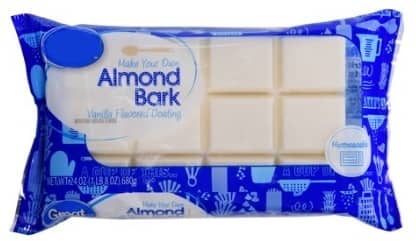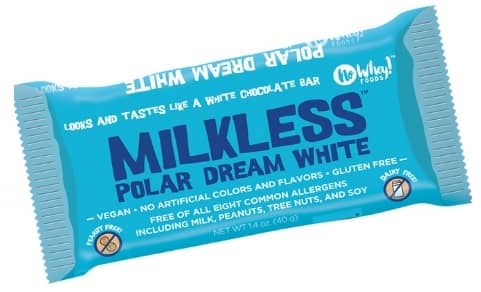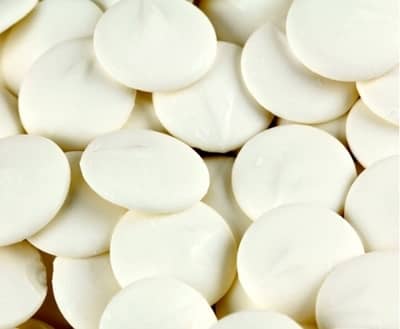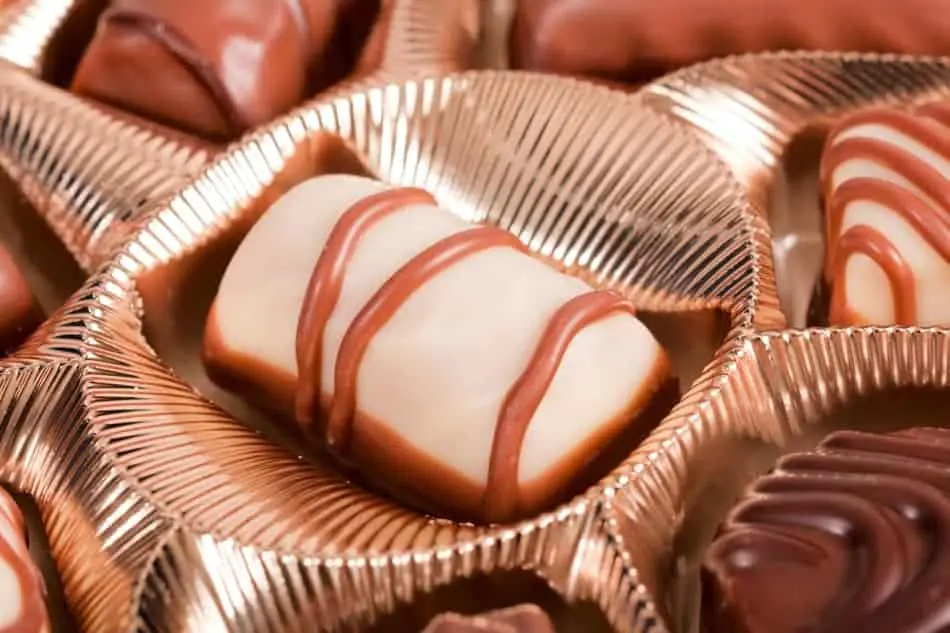White chocolate is a popular confection made with cocoa butter, sugar, and milk. What sets it apart is that it doesn’t contain any cocoa solids (or what’s commercially known as cocoa or cacao powder).1 For this reason, it’s characterized by a pale off-white or ivory color.2
Is it vegan? It’s complicated, but commercially, white chocolate is not considered vegan. Current regulations govern what can be labeled as “white chocolate” by specifying certain parameters for the amount of cocoa butter, milk solids, and milk fat that must be present to bear the label.
Since 2004, the US requires products labeled “white chocolate” to be at least 20%, 14%, and 3.5% (by weight) for cocoa butter, total milk solids, and milk fat, respectively. The products must also be no more than 55% sugar/sweeteners by weight.3
But, it is complicated. Technically, white chocolate is not even considered chocolate at all, nor is it recognized by the FDA as such.4
This is because white chocolate is defined as not containing any chocolate liquor or cocoa.5
The basic ingredients for white chocolate include sugar, milk, cocoa butter, natural flavor, lecithin, and vanillin.4
If the cocoa butter were to be removed from white chocolate, the resulting product would have nothing to do with cocoa beans at all and would be more of a white coating or confectionery coating.4
How do you know when white chocolate is vegan? You’ll need to look for fancy names that don’t actually contain “white chocolate” in the description. This will be a manufacturer’s way of getting around the current regulations. If you see something like “white dreams” or what have you, then you just might have some vegan white chocolate. Scan the ingredients label for milk and milk derivatives (whey, dry milk powder, etc.).
The Sense in Which There Is Vegan White Chocolate
Though it can’t be advertised as such, there is a way in which white chocolate could technically be considered diary-free and thus vegan. Cocoa butter is still white and it’s still chocolate, so in that sense, there is vegan white chocolate. Just add the sugar and surfactants, and you’re good to go.
The above regulations came about because manufacturers were making cheap white chocolate by replacing cocoa butter (the natural plant-based fats present in cocoa beans) with cheap hydrogenated oils.
Hershey’s and other chocolate brands got kind of territorial with the food product and didn’t want their higher-quality white chocolate (with cocoa butter) to be conflated with the cheaper stuff on the market.
Nowadays, the cheap versions of white chocolate are still available, but they’re now referred to as almond bark. I’m not exactly sure how they got that name, because there’s no almond extract in the mix.

They come in big blocks that are meant to be melted down to make confections. These are not vegan, by the way—I’m just mentioning them to explain how the regulations came about.
Consider the Dark Chocolate Bar
Keep in mind, much of the dark chocolate on the market contains zero milk products. It’s odd that the baseline for what’s considered chocolate requires no milk, but you have to have milk in a product for it to be considered white chocolate.
If you were to forego the milk products and produce a bar containing cocoa butter, sugar, and a surfactant, the resulting food would be the dark chocolate equivalent of white chocolate.
And there are plenty of such products on the market now. It’s just that, since 2004, we’re no longer allowed to refer to such products as white chocolate.
What Ingredients Would Vegan White Chocolate Contain?
Cocoa Butter
Cocoa butter aka theobroma oil is an off-white or pale-yellow, edible veggie fat present in cocoa beans.6
Along with palm and coconut oil, it’s a rare source of plant-based saturated fat. It’s melting point is high enough to keep chocolate products solid at room temp.2
Which is why the cheap versions of “white chocolate” used hydrogenated vegetable oils. When you hydrogenate oils, you’re adding a bunch of hydrogen atoms to the fatty acid chains making them linear like saturated fat. This allows them to tightly adhere which is why a substance containing them only melts at higher temperatures.
Dark chocolate contains the stuff, often as the sole fat source, though some dark chocolate candy makers include milk products in the mix (e.g. Hershey’s).
If you’ve ever had dairy-free dark chocolate chips, you probably noticed they were a bit brittle. This is because cocoa butter is a brittle substance and doesn’t quite have the same mouthfeel as other sources of saturated fat.
Lecithin
Lecithin is a compound present abundantly in eggs and certain plant foods like soy and sunflower oils. It’s a fatty substance that attracts both water and fat molecules helping ingredients to stay nice and mixed. It’s actually used for its surfactant properties, in that it helps lower the viscosity of the white chocolate making it easier to work with.
Above it was mentioned that chocolates only containing cocoa butter (without milk fat) tend to be on the brittle side. If you’ve ever had non-dairy chocolate that had a smooth texture, it’s likely due to the presence of surfactant. Soy lecithin is used to soften up non-dairy chocolates giving them a smoother mouthfeel.
Vanilla
Vanilla extract is a common ingredient in white chocolate. White chocolate doesn’t always contain the stuff, but most varieties contain vanilla and other flavoring ingredients.7
Sugar
Often times bakers chocolate comes as unsweetened. Baking applications for chocolate have their own set of ingredients so manufacturers don’t want consumers to have to factor in sugar in the candy when making chocolate treats.
But, I’ve never run across a white chocolate product that was sugar-free. For that, you have pure cocoa butter in the baking isles—at least, in upscale markets like Whole Foods.
This kind of goes to the point that it’s so arbitrary that white chocolate has to have milk products in it for labeling purposes. After all, pure cocoa butter is really just the white chocolate equivalent to baker’s chocolate.
Thickeners
Dextrose is a common thickener used in candy making to thicken and stabilize.
Then there’s tragacanth which is a natural gum derived from the dried sap of certain species of Middle Eastern legumes.8-10
It’s a somewhat common ingredient in candy making. It’s a substance that’s used in foods and pharmaceuticals as a thickener, surfactant, stabilizer, and texturant additive (E number E413).11
Commercial Vegan White Chocolate
No Whey Foods Polar White Dream

No Whey Foods has a milkless chocolate bar that’s both vegan and gluten-free called Polar Dream White.
It contains:12
- Vegan cane sugar
- Cocoa butter
- Sunflower lecithin
- Natural vanilla
- Dextrose
- Tragacanth gum (natural thickener)
- Natural flavor
I’ve had one of these, and they are really indistinguishable from standard white chocolate.
Non-Dairy White Melting Chocolate Wafers

These are marketed as “white melting chocolate wafers” which is a clever way of getting around the current regulations—you’ll notice they slapped “melting” in between “white” and “chocolate”. Anyway, it’s essentially white chocolate that’s sold for use in baked goods.
So, if you like to cook with white chocolate, this may be the product for you. These have hydrogenated oils, but unlike the pseudo white chocolate “almond bark”, they don’t contain any milk products.
These contain:13
- Sugar
- Partially Hydrogenated Palm Oil
- Maltodextrin
- Soy Lecithin
- Vanillin (an Artificial Flavor)
- Salt
There are other white chocolate products on the market that are suitable for vegans, but this will give you a good idea of what’s out there.
Anyway, that wraps it up for vegan white chocolate. Thanks for reading.
You may also want to check out the following related articles:
- Are Andes Mints Vegan? What About Junior Mints?
- Is Angel Food Cake Vegan?
- Are Tootsie Rolls and Pops Vegan? (Plus Best Alternatives)
- Are Jolly Ranchers Vegan?
- Are Swedish Fish Vegan? The Bottom Line
References
- “White chocolate”. Bon Appétit. 12 November 2007. https://www.bonappetit.com/test-kitchen/tools-test-kitchen/article/white-chocolate
- White Chocolate. https://en.wikipedia.org/wiki/White_chocolate
- “Title 21 Chapter I Subchapter B Part 163 of the Code of Federal Regulations”. United States Government Publishing Office. 24 February 2017. https://www.ecfr.gov/cgi-bin/text-idx?SID=64ec925fd70dcc3f30f6c45d41315509&mc=true&node=pt21.2.163&rgn=div5#se21.2.163_1124
- Understanding Food: Principles and Preparation (Page 530). Amy Brown – Wadsworth Cengage Learning – 2011. ISBN-10: 0-538-73498-1
- Giannatempo L. Shopping for white chocolate. Fine Cooking 91:78, 2008.
- “Cocoa butter”. Encyclopædia Britannica. July 1998. https://www.britannica.com/topic/cocoa-butter
- Blumberg, Naomi. “Chocolate”. Encyclopædia Britannica Online. https://www.britannica.com/topic/chocolate
- Japanese Pharmacopoeia (PDF) (15th ed.). Archived from the original (PDF) on 2011-07-22. https://web.archive.org/web/20110722105441/http://jpdb.nihs.go.jp/jp15e/JP15.pdf
- “Astragalus adscendens Persian Manna PFAF Plant Database”. www.pfaf.org. https://pfaf.org/user/Plant.aspx?LatinName=Astragalus+adscendens
- “Astragalus brachycalyx Fisch”. Germplasm Resources Information Network (GRIN). Agricultural Research Service (ARS), United States Department of Agriculture (USDA). https://npgsweb.ars-grin.gov/gringlobal/taxonomydetail.aspx?433295
- Tragacanth. https://en.wikipedia.org/wiki/Tragacanth
- Chocolate Bar – White Polar Dream. https://www.nowheychocolate.com/Milk_Free_Nut_Free_Gluten_Free_p/vegan-chocolate-white-bars.htm
- Non-Dairy White Melting Chocolate Wafers. https://www.ohnuts.com/buy.cfm/baked-goods-baking-supplies/candy/chocolate-melting-wafers/non-dairy-white?pre=43815&gclid=EAIaIQobChMI4fmUheGR4wIVJv7jBx0aJAytEAQYASABEgKB2_D_BwE

